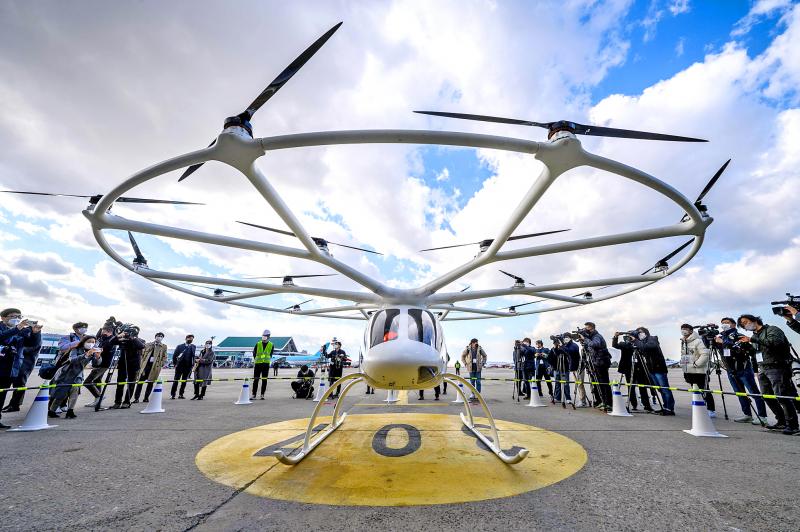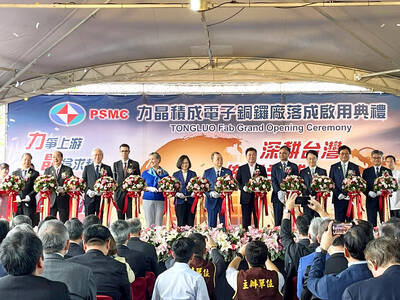The Jetsons are back and they are looking green.
Electric flying taxis were the toast of the Singapore Airshow, which ended on Feb. 18. AirAsia and a unit of Embraer SA announced deals for nearly 200 of the futuristic vehicles, which have not made it beyond prototype stage yet.
Such electric vertical take off and landing (eVTOL) vehicles have seen an explosion of interest in the past few years, with about US$12.8 billion invested in the field since 2010, McKinsey & Co data show.

Photo: AFP
The promise of this booming sector is that they are selling something fundamentally different than the original VTOL aircraft: helicopters.
Unlike their noisy, fuel-guzzling predecessors — the transport mode of choice for Bond villains and former US president Donald Trump — eVTOLs will quietly buzz a more ethical breed of passenger between office and home, “connecting communities” and linking the city and the suburbs “in one swift, smooth and emissions-free flight.”
It is a magnificent triumph of marketing over reality.
While eVTOLs promise some genuine advances in aviation technology, the investments being made will not so much bring about that Utopian future as rebrand the dystopian old helicopter industry for a new generation of super-rich people.
If the promise of whisper-quiet, affordable, zero-emissions transport sounds too good to be true, that is because it is.
Take energy efficiency. It has always been true that aircraft in cruising flight are remarkably efficient relative to cars and trains that use friction to drag themselves laboriously along the ground. The problem is how to get up there.
Climbing and, to a lesser extent, descending have always taken up an outsize share of fuel consumption in aircraft. That is particularly the case with VTOL vehicles, which can use up a substantial share of their energy just hovering to treetop height. That means the differences between an eVTOL used to travel from one city to another, and one used to travel from one suburb to another are overwhelming.
One 2019 study in Nature Communications said that eVTOLs could be more efficient than even electric cars for 100km journeys, but added that 85 percent of car trips are shorter than 35km — a level at which a conventional gas-guzzling automobile results in about the same emissions as the flying car.
Occupancy also tends to be a critical assumption. A study last year in the Proceedings of the National Academy of Sciences argued that vehicles like the Larry Page-backed Kitty Hawk Heaviside are already more efficient than electric cars — but a crucial aspect of both analyses is the idea that ground-based modes should be judged by the 1.67 occupants who are carried per trip across the entire US vehicle fleet, whereas eVTOLs should be measured at ideal capacity levels.
That is not a reasonable comparison. If there is not a full complement of fresh passengers to be picked up each time a flying car touches down, its efficiency per passenger, per kilometer drops drastically.
Such “empty leg” flights, where an aircraft goes to its next destination with no passengers at all, make up about two-fifths of trips in actually existing private jets. Indeed, there is an entire cottage industry dedicated to finding cheap tickets on them.
It is a similar picture with sound pollution. By having several small rotors rather than one big one, most eVTOLs promise to be less noisy — “almost 1,000 times quieter” than a helicopter, Archer Aviation Inc says.
While decibels are a useful objective measure of sound pressure, they do not correspond much to the subjective annoyance factor for noise, which relates to harder-to-measure qualities such as frequency, duration, repetition and the way sound reflects from building surfaces in an urban environment. Noise also corresponds a lot to distance, making an eVTOL quieter the higher its cruising altitude.
However, climb higher and you are using more fuel again. It is almost impossible to be energy-efficient and noise-efficient at the same time.
Perhaps this does not matter. For all the excitement around eVTOLs, they are likely to account for a rather small portion of overall traffic in the future, next to the workhorses of buses, trains, cars and low-cost jets in which passengers will be crammed into ever-smaller seats.
The trouble is, they are a distraction from the real problems the aviation industry needs to be dealing with — most of all, the question of how the vast majority of us will travel by the middle of this century without our carbon emissions destroying the atmosphere through which we fly.
About three-quarters of investments in future aviation technology since 2010 have gone into urban flying taxis and similar technologies, McKinsey & Co says, with the urgent question of sustainable aviation attracting only cents on the dollar by comparison.
A grimly plausible vision of the future will see non-fungible token billionaires travel from San Francisco to their weekend escapes in Lake Tahoe, blithely ignorant of their true carbon footprints.
The city-dwellers over whom they fly will be stuck in endless traffic, which the political system never seems to get around to solving.
Once they get home, they will be constantly buzzed by the sound of passing eVTOLs they could never afford to fly, thanks to the way spurious arguments about decibels managed to loosen long-standing aircraft noise regulations.
Perhaps eVTOLs are the future of mobility. If they are, it is not something to be proud of. It is an admission that transport policy — as something designed to move the mass of humanity from place to place, rather than something to serve the interests of an oblivious elite — has comprehensively failed.

ARTIFICIAL INTELLIGENCE: The chipmaker last month raised its capital spending by 28 percent for this year to NT$32 billion from a previous estimate of NT$25 billion Contract chipmaker Powerchip Semiconductor Manufacturing Corp (力積電子) yesterday launched a new 12-inch fab, tapping into advanced chip-on-wafer-on-substrate (CoWoS) packaging technology to support rising demand for artificial intelligence (AI) devices. Powerchip is to offer interposers, one of three parts in CoWoS packaging technology, with shipments scheduled for the second half of this year, Powerchip chairman Frank Huang (黃崇仁) told reporters on the sidelines of a fab inauguration ceremony in the Tongluo Science Park (銅鑼科學園區) in Miaoli County yesterday. “We are working with customers to supply CoWoS-related business, utilizing part of this new fab’s capacity,” Huang said, adding that Powerchip intended to bridge

BUSINESS UPDATE: The iPhone assembler said operations outlook is expected to show quarter-on-quarter and year-on-year growth for the second quarter Hon Hai Precision Industry Co (鴻海精密) yesterday reported strong growth in sales last month, potentially raising expectations for iPhone sales while artificial intelligence (AI)-related business booms. The company, which assembles the majority of Apple Inc’s smartphones, reported a 19.03 percent rise in monthly sales to NT$510.9 billion (US$15.78 billion), from NT$429.22 billion in the same period last year. On a monthly basis, sales rose 14.16 percent, it said. The company in a statement said that last month’s revenue was a record-breaking April performance. Hon Hai, known also as Foxconn Technology Group (富士康科技集團), assembles most iPhones, but the company is diversifying its business to

Microsoft Corp yesterday said that it would create Thailand’s first data center region to boost cloud and artificial intelligence (AI) infrastructure, promising AI training to more than 100,000 people to develop tech. Bangkok is a key economic player in Southeast Asia, but it has lagged behind Indonesia and Singapore when it comes to the tech industry. Thailand has an “incredible opportunity to build a digital-first, AI-powered future,” Microsoft chairman and chief executive officer Satya Nadella said at an event in Bangkok. Data center regions are physical locations that store computing infrastructure, allowing secure and reliable access to cloud platforms. The global embrace of AI

Qualcomm Inc, the world’s biggest seller of smartphone processors, gave an upbeat forecast for sales and profit in the current period, suggesting demand for handsets is increasing after a two-year slump. Revenue in the three months ended in June will be US$8.8 billion to US$9.6 billion, the company said in a statement Wednesday. Excluding certain items, earnings will be US$2.15 to US$2.35 a share. Analysts had projected sales of US$9.08 billion and earnings of US$2.16 a share. The outlook signals that the smartphone market has begun to bounce back, tracking with Qualcomm’s forecast that demand would gradually recover this year. The San